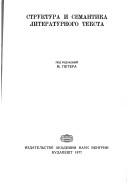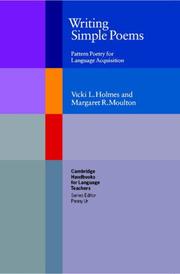| Listing 1 - 10 of 15 | << page >> |
Sort by
|
Book
ISBN: 1780675607 9781780675602 9781780675527 1780675526 1780673477 9781780673479 9781780673479 Year: 2014 Publisher: London King
Abstract | Keywords | Export | Availability | Bookmark
 Loading...
Loading...Choose an application
- Reference Manager
- EndNote
- RefWorks (Direct export to RefWorks)
The first typewriter artist to find fame was Flora F. F. Stacey, with her butterfly drawing of 1898; but since the very beginning of the typewriter's existence, artists, designers, poets, and writers have used this rigorous medium to produce an astounding range of creative work.This beautiful book brings together some of the best examples by typewriter artists around the world. As well as key historical work from the Bauhaus, H. N. Werkman, and the concrete poets, there is art by contemporary practitioners, both typewriter artists who use the keyboard as a ""palette"" to create artworks, and a
Typewriter art. --- Art, Typewriter --- Art, Modern --- Typewriting --- Visual literature --- Graphic arts
Book
Year: 1992 Publisher: London : New York : Anthony d'Offay Gallery ; Paula Cooper Gallery,
Abstract | Keywords | Export | Availability | Bookmark
 Loading...
Loading...Choose an application
- Reference Manager
- EndNote
- RefWorks (Direct export to RefWorks)
This book was typed in 1972 with the theme relating to the action photographs of Eadweard Muybridge.
Art de la machine à écrire. --- Artists' books --- Artists' books. --- Livres d'artistes --- Typewriter art. --- United States.
Book
ISBN: 2283020565 Year: 2004 Publisher: Paris Buchet-Chastel
Abstract | Keywords | Export | Availability | Bookmark
 Loading...
Loading...Choose an application
- Reference Manager
- EndNote
- RefWorks (Direct export to RefWorks)
Dotremont, Christian --- Letter-pictures --- Calligraphic paintings --- Peinture lettriste --- Art, Modern --- Dadaism --- Futurism (Art) --- Lettrism --- Typewriter art --- Visual literature --- Visual poetry --- Dotremont, Christian, --- Themes, motives.
Book
ISBN: 9789188829115 9188829111 Year: 2021 Publisher: Stockholm OEI
Abstract | Keywords | Export | Availability | Bookmark
 Loading...
Loading...Choose an application
- Reference Manager
- EndNote
- RefWorks (Direct export to RefWorks)
Catalogue raisonné of the 119 Lettrist reviews published between 1946 and 2016.
Lettrism --- kunst --- magazines --- tijdschriften --- lcatalogue raisonné --- 7.038 --- 7.038/039 --- naslagwerk --- literatuur --- film --- lettrisme --- twintigste eeuw --- Aesthetics --- Art --- Literature --- Typewriter art --- Visual poetry --- Visual literature --- Lettrisme
Book
ISBN: 9022306283 Year: 1977 Publisher: Brussel Manteau
Abstract | Keywords | Export | Availability | Bookmark
 Loading...
Loading...Choose an application
- Reference Manager
- EndNote
- RefWorks (Direct export to RefWorks)
Poetry --- Concrete poetry --- -Gedichten: bloemlezing --- Poëzie --- Pattern poetry --- Concrete art --- Letter-pictures --- Typewriter art --- Visual literature --- Visual poetry --- History and criticism --- Concrete poetry. --- Visual poetry. --- History and criticism. --- Gedichten: bloemlezing

ISBN: 9630510030 9789630510035 Year: 1977 Publisher: Budapest Akademiai Kiado
Abstract | Keywords | Export | Availability | Bookmark
 Loading...
Loading...Choose an application
- Reference Manager
- EndNote
- RefWorks (Direct export to RefWorks)
Papers presented at the Conference of the Subcommittee for Slavonic poetics and stylistics of the International Committee of Slavists, held at Tihany (Hungary), May 26 to 29, 1974
Linguistics --- Literary semiotics --- Literature --- Slavic languages --- Poetics --- Concrete poetry --- Versification --- Congresses --- History and criticism --- -Poetics --- -Slavic languages --- -Balto-Slavic languages --- Slavonic languages --- Indo-European languages --- Poetry --- Pattern poetry --- Concrete art --- Letter-pictures --- Typewriter art --- Visual literature --- Visual poetry --- -Congresses --- Technique --- -History and criticism --- Balto-Slavic languages --- History and criticism&delete& --- Versification&delete& --- Slavic languages - Versification - Congresses --- Poetics - Congresses --- Concrete poetry - History and criticism - Congresses
Book
ISBN: 9789082507676 9082507676 Year: 2018 Publisher: Antwerpen Woolf
Abstract | Keywords | Export | Availability | Bookmark
 Loading...
Loading...Choose an application
- Reference Manager
- EndNote
- RefWorks (Direct export to RefWorks)
Paul de Vree (1909-1982) was een katalysator van het artistieke experiment in Vlaanderen na de Tweede Wereldoorlog. Als dichter en als essayist heeft hij vooral vanaf de jaren zestig een belangrijke rol gespeeld in het debat over poëzie, beeldende kunst, muziek en experiment. Hij staat geboekstaafd als vertegenwoordiger van de konkrete poëzie en introduceerde de "poesia visiva" in de Vlaamse letteren. In de programmatische essays vlaamse avant-garde (1921-1964) (1965) en poëzie in fusie (1968) breekt hij een lans voor een ver doorgedreven experiment waarbij poëzie in een intermediale context wordt geplaatst. Beide teksten verschenen als Bladen voor de Poëzie en verschijnen voor het eerst in een tekstkritische uitgave.
Poetry --- avant-garde --- Dutch literature --- Vree, De, Paul --- Poëzie --- Nederlandse letterkunde --- Flemish literature --- Concrete poetry --- Visual poetry --- Visual literature --- Pattern poetry --- Concrete art --- Letter-pictures --- Typewriter art --- History and criticism --- Vree, Paul de. --- de Vree, Paul --- Vree, Paul de --- de Vree, Paul Rosa Oscar
Book
ISBN: 9780500241493 050024149X Year: 2015 Publisher: London Thames & Hudson
Abstract | Keywords | Export | Availability | Bookmark
 Loading...
Loading...Choose an application
- Reference Manager
- EndNote
- RefWorks (Direct export to RefWorks)
The beloved typewriter--its utilitarian beauty, the pleasing percussive action of striking its keys, the singularity of the impressed page--is enjoying a genuine renaissance across the creative industries. In this authoritative publication, the founders of the Sackner Archive of Visual and Concrete Poetry, the largest such collection in the world, apply their experience, mining the collection they have created over four decades to present examples produced by more than 200 of the world's finest typewriter artists. From the early ornamental works produced by secretaries in the late nineteenth century to more recent works that consider the unique position of the typewritten document in the digital age, there is an astonishing and delightful range of creativity in every artwork.
Typewriter art --- kunst --- 7.038/039 --- 7.038 --- eenentwintigste eeuw --- concept art --- conceptuele kunst --- kunst en literatuur --- poëzie --- woord en beeld --- concrete poëzie --- tikmachines --- typemachines --- twintigste eeuw --- schrijfmachines --- Art, Typewriter --- Art, Modern --- Typewriting --- Visual literature --- 766:655.262 --- udc --- Visuele poëzie ; poëtische typografie --- Collages --- Kunstgeschiedenis ; 1950 - 2000 --- Gebruiksgrafiek ; typografie ; tekstverdeling
Book
ISBN: 1771121343 1771121335 9781771121330 9781771121323 Year: 2015 Publisher: Waterloo, Ontario Ottawa, Ontario
Abstract | Keywords | Export | Availability | Bookmark
 Loading...
Loading...Choose an application
- Reference Manager
- EndNote
- RefWorks (Direct export to RefWorks)
Sonosyntactics introduces the reader to over forty-five years of Paul Dutton’s diverse and inventive poetry, ranging from lyrics, prose poems, and visual work to performance texts and scores. Perhaps best known for his acclaimed solo sound performances and his contributions to the iconic sound poetry group The Four Horsemen, Dutton is a surprising, witty, sensitive, and innovative explorer of language and of the human. This volume gathers a representative selection of his most significant and characteristic poetry together with a generous selection of uncollected new work. Sonosyntactics demonstrates Dutton’s willingness to (re)invent and stretch language and to listen for new possibilities while at the same time engaging with his perennial concerns—love, sex, music, time, thought, humour, the materiality of language, and poetry itself. Gary Barwin’s introduction outlines the major subjects and techniques of Dutton’s poetry: an intricate weaving of thought and language, sound and emotion, sound and sense, and the unfolding of a text through the logic of language play such as puns, paradoxes, ambiguity, and sound relations. In an afterword by Dutton himself, the poet insightfully lays out the terms of his engagement with the materiality—both visual and aural—of language, often beyond the purely recountable, representational, or depictive.
Canadian poetry --- Canadian poetry --- 21st century. --- Canadian literature. --- Canadian poetry. --- Four Horsemen. --- Gary Barwin. --- Paul Dutton. --- concrete poetry. --- dirty concrete. --- experimental poetry. --- jazz poetry. --- lyric poetry. --- narrative poetry. --- poetry. --- prose poetry. --- serial poetry. --- sound poetry. --- typewriter art. --- typewriter poetry. --- vispo. --- visual poetry.

ISBN: 0521785529 Year: 2001 Publisher: Cambridge Cambridge University press
Abstract | Keywords | Export | Availability | Bookmark
 Loading...
Loading...Choose an application
- Reference Manager
- EndNote
- RefWorks (Direct export to RefWorks)
Concrete poetry --- Creative writing --- English language --- Germanic languages --- Pattern poetry --- Concrete art --- Letter-pictures --- Poetry --- Typewriter art --- Visual literature --- Visual poetry --- Authorship&delete& --- Study and teaching --- Study and teaching&delete& --- Foreign speakers --- Didactic strategies --- Didactics of English --- talenonderwijs --- poëzie --- Engels --- didactische werkvormen --- Authorship --- EFL (Language study) --- English as a foreign language --- English as a second language --- English to speakers of other languages --- ESL (Language study) --- ESOL (Language study) --- Teaching English as a second language --- TEFL (Language study) --- TESL (Language study) --- Foreign students
| Listing 1 - 10 of 15 | << page >> |
Sort by
|

 Search
Search Feedback
Feedback About UniCat
About UniCat  Help
Help News
News